Trevelyon's Gold Cap
Trevelyon's Gold Cap! After months of debating, drawing, thinking, planning, rethinking...I've decided to embroider a second cap based on a design of Thomas Trevelyon. This time I'm going to embroider the cap using mainly (but not only) metal thread techniques.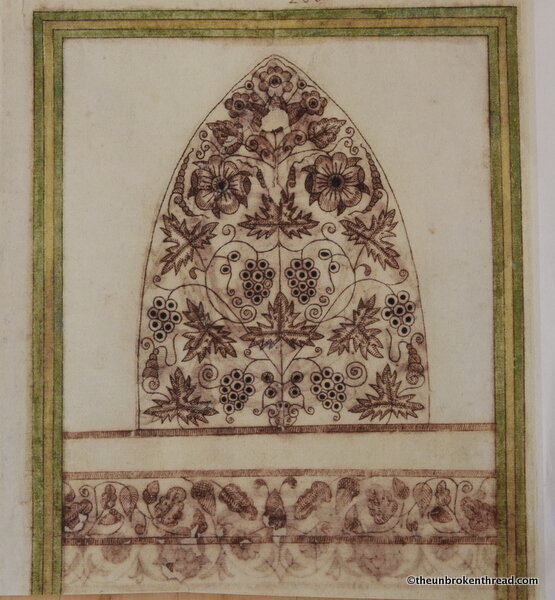 I've spent some time researching caps like this and, although I couldn't find any that were worked entirely in metal threads, I found quite a few that used a combination of metal threads, mainly silver gilt, along with other threads and techniques.The first cap, below, was sold at Christies Auction House in 2006. It's from the 17th century and embroidered on red velvet. Here is the description from the auction catalogue."A "CROMWELLIAN" GENTLEMAN'S NIGHT CAP 17TH CENTURYOf red velvet embroidered in metal threads with pomegranates and embellished with spangles, with inscribed tag:"This cap belonged to Major Buntine, uncle of William Baillie of Monkton. He served under General Lesley in the Civil Wars; and particularly distinguished [sic] at Philiphaugh. Cromwell made him Master of the Horse in Scotland. Monk sent him to Breda to see Charles II"7 in. (18 cm.) high; 11 in. (28 cm.) diam. "For more information, please visit Christie's web site here.
I've spent some time researching caps like this and, although I couldn't find any that were worked entirely in metal threads, I found quite a few that used a combination of metal threads, mainly silver gilt, along with other threads and techniques.The first cap, below, was sold at Christies Auction House in 2006. It's from the 17th century and embroidered on red velvet. Here is the description from the auction catalogue."A "CROMWELLIAN" GENTLEMAN'S NIGHT CAP 17TH CENTURYOf red velvet embroidered in metal threads with pomegranates and embellished with spangles, with inscribed tag:"This cap belonged to Major Buntine, uncle of William Baillie of Monkton. He served under General Lesley in the Civil Wars; and particularly distinguished [sic] at Philiphaugh. Cromwell made him Master of the Horse in Scotland. Monk sent him to Breda to see Charles II"7 in. (18 cm.) high; 11 in. (28 cm.) diam. "For more information, please visit Christie's web site here.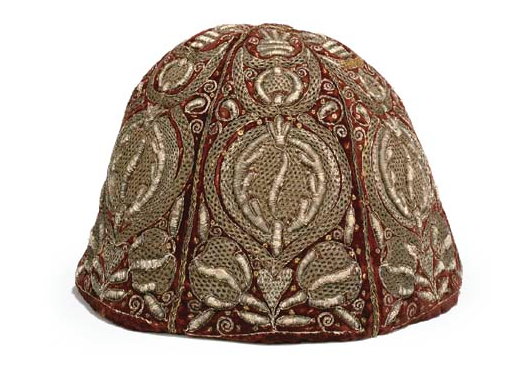 The next cap that provided me with inspiration is part of the collection of the Metropolitan Museum of Art in New York. Here is part of their catalogue description.
The next cap that provided me with inspiration is part of the collection of the Metropolitan Museum of Art in New York. Here is part of their catalogue description.
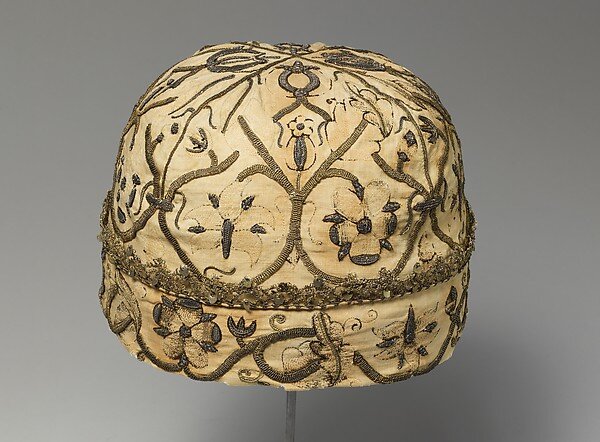 The last two caps both come from the Victoria and Albert Museum in London. The first is a gentleman's night cap made between 1600 and 1625. The threads are silver gilt and silk. The description is as follows:"This nightcap is an example of informal headwear for a wealthy man. Headwear was a significant part of dress in the 17th century, for reasons of both fashion and warmth, and although nightcaps were only worn around the home, they could be, like this example, very luxurious."You can learn more about this cap here, at the V&A website.
The last two caps both come from the Victoria and Albert Museum in London. The first is a gentleman's night cap made between 1600 and 1625. The threads are silver gilt and silk. The description is as follows:"This nightcap is an example of informal headwear for a wealthy man. Headwear was a significant part of dress in the 17th century, for reasons of both fashion and warmth, and although nightcaps were only worn around the home, they could be, like this example, very luxurious."You can learn more about this cap here, at the V&A website.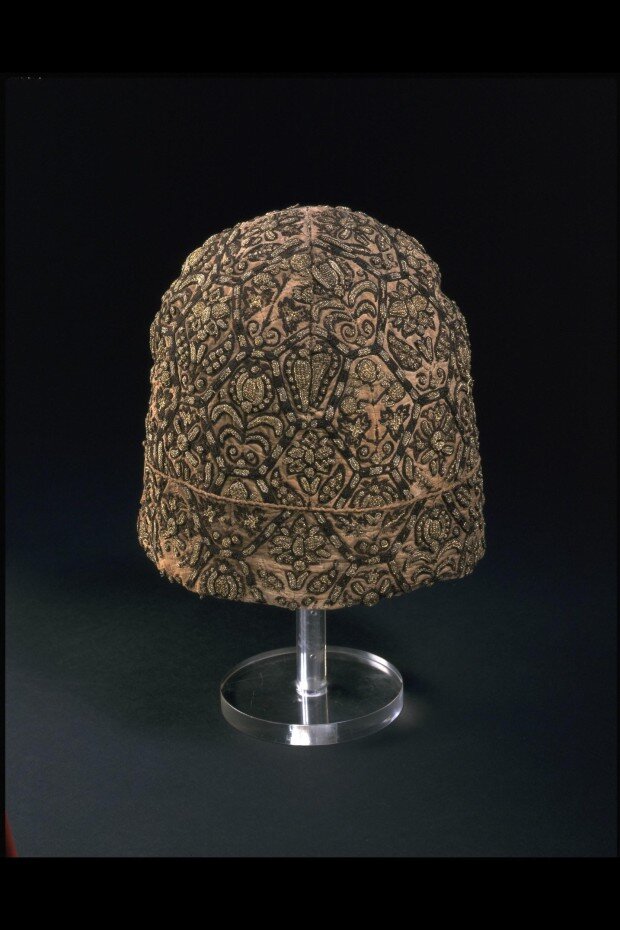 This last item is not a gentleman's cap but a coif, made for a woman. I've seen this one (and the one above) when I visited the V&A and the coif really captured my imagination. I just love the combination of gold and black on ivory linen. And, when you see the pattern I'm using from Thomas Trevelyon, you can see similarities in the design. The description tells us that;"Woman's embroidered coif (cap), 1600-25. Museum no. T.27-1975Woman's embroidered coif (cap)England1600-25linen, silk & silver-gilt, threadMuseum no. T.27-1975Woman’s coif embroidered in blackwork, English, early 17th century."I just love the blackwork seeding in the pointed leaves!
This last item is not a gentleman's cap but a coif, made for a woman. I've seen this one (and the one above) when I visited the V&A and the coif really captured my imagination. I just love the combination of gold and black on ivory linen. And, when you see the pattern I'm using from Thomas Trevelyon, you can see similarities in the design. The description tells us that;"Woman's embroidered coif (cap), 1600-25. Museum no. T.27-1975Woman's embroidered coif (cap)England1600-25linen, silk & silver-gilt, threadMuseum no. T.27-1975Woman’s coif embroidered in blackwork, English, early 17th century."I just love the blackwork seeding in the pointed leaves! 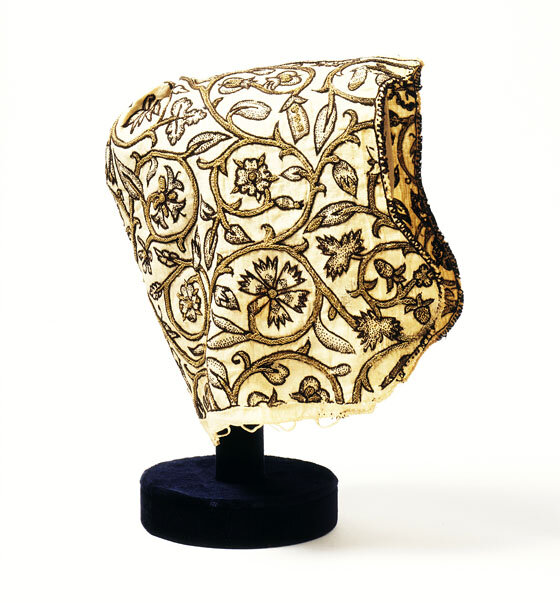 This morning, I spent my time drawing and re-drawing the design until I was confident it was simple enough to embroider in miniature but still complex enough to be true to the original drawn by Trevelyon. Then I got out my metal threads and played!Here's a photo of the threads I MIGHT use. It will be another project where I learn as I work, since I've not done any metal thread work on such a small scale. I'll be doing sample stitches and stitch combinations using both traditional metal threads and modern threads as I work, so I can be sure everything I decide to do on the cap will work in the small shapes of the design.
This morning, I spent my time drawing and re-drawing the design until I was confident it was simple enough to embroider in miniature but still complex enough to be true to the original drawn by Trevelyon. Then I got out my metal threads and played!Here's a photo of the threads I MIGHT use. It will be another project where I learn as I work, since I've not done any metal thread work on such a small scale. I'll be doing sample stitches and stitch combinations using both traditional metal threads and modern threads as I work, so I can be sure everything I decide to do on the cap will work in the small shapes of the design.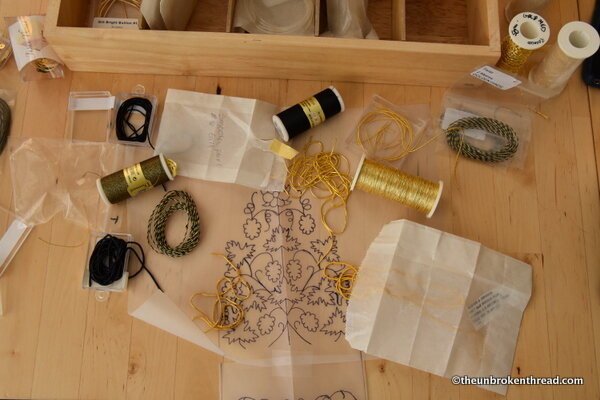 I'm excited! When it's finished, I think it will look fabulous next to the first cap - and isn't it always better to have two caps in case you lose one?
I'm excited! When it's finished, I think it will look fabulous next to the first cap - and isn't it always better to have two caps in case you lose one?
